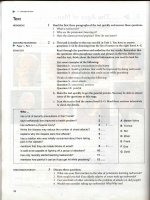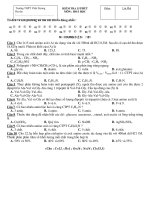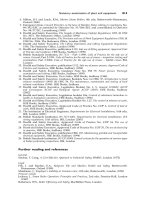Astm e 1281 15
Bạn đang xem bản rút gọn của tài liệu. Xem và tải ngay bản đầy đủ của tài liệu tại đây (100.85 KB, 6 trang )
Designation: E1281 − 15
Standard Guide for
Nuclear Facility Decommissioning Plans1
This standard is issued under the fixed designation E1281; the number immediately following the designation indicates the year of
original adoption or, in the case of revision, the year of last revision. A number in parentheses indicates the year of last reapproval. A
superscript epsilon (´) indicates an editorial change since the last revision or reapproval.
INTRODUCTION
As a nuclear facility approaches the end of its operational life, the operator should initiate final
preparations for decommissioning. As part of this program, a decommissioning plan should be
developed to comply with applicable federal and state requirements and regulations, as well as to
provide generic and detailed information relevant to decommissioning project planning. This standard
is a guideline for the preparation and content of the decommissioning plan.
2. Referenced Documents
1. Scope
2.1 ASTM Standards:2
E1034 Specification for Nuclear Facility Transient Worker
Records
E1167 Guide for Radiation Protection Program for Decommissioning Operations
E1168 Guide for Radiological Protection Training for
Nuclear Facility Workers
E1760 Guide for Unrestricted Disposition of Bulk Materials
Containing Residual Amounts of Radioactivity
E1819 Guide for Environmental Monitoring Plans for Decommissioning of Nuclear Facilities
E1892 Guide for Preparing Characterization Plans for Decommissioning Nuclear Facilities
E1893 Guide for Selection and Use of Portable Radiological
Survey Instruments for Performing In Situ Radiological
Assessments to Support Unrestricted Release from Further Regulatory Controls
E2216 Guide for Evaluating Disposal Options for Concrete
from Nuclear Facility Decommissioning
E2420 Guide for Post-Deactivation Surveillance and Maintenance of Radiologically Contaminated Facilities
E2421 Guide for Preparing Waste Management Plans for
Decommissioning Nuclear Facilities
2.2 Code of Federal Regulations:3
10 CFR 19 Notices, Instructions and Reports to Workers;
Inspections
1.1 This guide applies to decommissioning plans for any
nuclear facility whose operation was (is) governed by Nuclear
Regulatory Commission (NRC), Agreement State license,
under Department of Energy (DOE) orders, or whose operation
was overseen by another federal, state, or local agency.
1.2 The guide applies to the preparation and content of the
decommissioning plan document itself.
1.3 The detailed description and development of implementation plans identified in Section 4 is outside the scope of this
guide.
NOTE 1—Nuclear facilities operated by the U.S. DOE are not licensed
by the U.S. NRC, nor are other nuclear facilities which may come under
the control of the U.S. Department of Defense or individual agreement
states. The references in this guide to licensee, U.S. NRC Regulatory
guides, and Title 10 of the U.S. Code of Federal Regulations are to imply
appropriate alternative nomenclature with respect to DOE, DOD, or
agreement state nuclear facilities. This distinction should not alter the
content of decommissioning plans for nuclear facilities.
1.4 This standard does not purport to address all of the
safety concerns, if any, associated with its use. It is the
responsibility of the user of this standard to establish appropriate safety and health practices and determine the applicability of regulatory limitations prior to use.
1
This guide is under the jurisdiction of Committee E10 on Nuclear Technology
and Applications and is the direct responsibility of Subcommittee E10.03 on
Radiological Protection for Decontamination and Decommissioning of Nuclear
Facilities and Components.
Current edition approved June 1, 2015. Published July 2015. Originally approved
in 1989. Last previous edition approved in 2010 as E1281-10. DOI: 10.1520/E128115.
2
For referenced ASTM standards, visit the ASTM website, www.astm.org, or
contact ASTM Customer Service at For Annual Book of ASTM
Standards volume information, refer to the standard’s Document Summary page on
the ASTM website.
3
Available from Superintendent of Documents, U.S. Government Printing
Office, Washington, DC 20402.
Copyright © ASTM International, 100 Barr Harbor Drive, PO Box C700, West Conshohocken, PA 19428-2959. United States
1
E1281 − 15
2.4 Department of Energy Standard:5
DOE Order O 435.1-1 “Radioactive Waste Management”
and Supporting Guides and Manuals
DOE Order 430.1B Real Property Assess Management
DOE Guide G430.1-3 Deactivation Implementation Guide
10 CFR 20 Standards for Protection Against Radiation
10 CFR 30 Rules of General Applicability to Domestic
Licensing of Byproduct Material
10 CFR 40 Domestic Licensing of Source Material
10 CFR 50 Domestic Licensing of Production and Utilization Facilities
10 CFR 51 Environmental Protection Regulations for Domestic Licensing and Related Regulatory Functions
10 CFR 61 Licensing Requirements for Land Disposal of
Radioactive Waste
10 CFR 70 Domestic Licensing of Special Nuclear Material
10 CFR 71 Packaging and Transportation of Radioactive
Materials
10 CFR 73 Physical Protection of Plants and Materials
10 CFR 140 Financial Protection Requirements and Indemnity Agreements
10 CFR 150 Exemption and Continued Regulatory Authority in Agreement States Under Section 274
10 CFR 170 Fees for Facilities, Materials, Import and
Export Licenses and Other Regulatory Services Under the
Atomic Energy Act of 1954, as Amended
10 CFR 830 Nuclear Safety Rules
10 CFR 835 Occupational Radiation Safety
29 CFR 1910.120 Hazardous Waste Operations and Emergency Response
40 CFR 190 Environmental Radiation Protection Standards
for Nuclear Power Operations
40 CFR 191 Environmental Radiation Protection Standards
for Management and Disposal of Spent Nuclear Fuel,
High Level Waste and Transuranic Waste
40 CFR 192 Health and Environmental Protection for
Uranium and Thorium Mill Tailings
40 CFR 260 Land Disposal Restrictions
49 CFR 190 and above Hazardous Materials Transportation
Regulations
3. Terminology
3.1 Definitions of Terms Specific to This Standard:
3.1.1 decommission, vt—to remove a nuclear facility safely
from service and reduce residual radioactivity to levels that
permit release of the property or facility for unrestricted use
and termination of any applicable license(s).
3.1.2 decontamination, n—those activities employed to reduce the levels of (radioactive) contamination in or on
structures, equipment, materials, and personnel.
3.1.3 dismantlement, n—the alternative in which the
equipment, structures, and portions of a facility and site
containing radioactive contaminants are removed or decontaminated to a level that permits the property to be released for
unrestricted use shortly after cessation of operations.
3.1.4 entombment, n—consists of placing the facility into
protective storage. Initial entombment activities consist of
removing the balance of plant contaminated components,
systems, and structures from the site and sealing all the
remaining contaminated and activated plant components and
systems within the entombment boundary. This structure provides for containment of the entire radioactive inventory
remaining on site during the entombment period. Other initial
activities would consist of processing and removing radioactive waste, securing a possession-only license, and implementing security and surveillance plans for the delay period.
Decommissioning is completed by either radioactive decay to
unrestricted use levels or by dismantlement to unrestricted use
levels. If dismantlement were selected following entombment,
additional activities would be initiated after 30 or more years
and would consist of radiation surveys, removal of the entombment structure and materials within it, processing and removal
of any remaining solid and liquid radioactive wastes, and
restoring/releasing the site for unrestricted use.
3.1.5 nuclear facility, n—a facility whose operations involve
(or involved) radioactive materials in such form or quantity
that a radiological hazard potentially exists to the employees or
the general public. Included are facilities that are (or were)
used to produce, process, or store radioactive materials. Some
examples are nuclear reactors (power, test, or research), fuel
fabrication plants, fuel reprocessing plants, uranium/thorium
mills, UF-6 production and enrichment plants, radiochemical
laboratories, and radioactive waste disposal sites.
3.1.6 safe storage, n—consists of placing and maintaining
the facility in protective storage. Initial safe storage operations
would consist of general plant decontamination activities,
radiation surveys, the processing and removal of radioactive
waste materials, securing a possession-only license, and the
implementation of security, surveillance, and maintenance
2.3 Nuclear Regulatory Commission Standards:4
NRC Regulatory Guide 1.86, Termination of Operating Licenses for Nuclear Reactors
NUREG-1757 Consolidated Decommissioning Guidance;
Volume 1, Decommissioning Process for Material Licenses; Volume 2, Characterization, Survey and Determination of Radiologial Criteria; Volume 3, Financial
Assurance, Recordkeeping, and Timeliness
NUREG-1575 Multi-Agency Radiation Survey and Site Investigation Manual (MARSSIM), Rev 1, August 2000
NUREG-1575 Supplement 1, Multi-Agency Radiation Survey and Assessment of Materials and Equipment (MARSAME)
NUREG-2082 Monitoring for Compliance with Decommissioning Termination Survey Criteria
Regulatory Guide 1.179 Standard Format and Content for
License Termination Plans for Nuclear Power Reactors
(NRC 1999)
4
Available from Nuclear Regulatory Commission, Public Document Room,
1717 H St., N.W., Washington, DC 20555.
5
Available from Dept. of Energy, National Technical Information Service, U.S.
Dept. of Commerce, Springfield, VA 22161.
2
E1281 − 15
licensing history, the operating record, and a summary of all
operating events that could affect decommissioning activities
(such as spills or releases of radioactive or contaminated
materials).
plans for the delay period. Decommissioning is completed by
dismantling following the protective storage period. The additional activities initiated after 30 or more years would be
essentially the same as those described for entombment, except
that there would be more systems removed after safe storage
than after entombment.
6. Characterization
6.1 A description of the entire nuclear facility to be decommissioned should be provided including results of a radiation
survey prior to initiation of other decommissioning activities.
Site characteristics that should be addressed include
topography, soils and geology, hydrology, seismology,
demography, and meteorology. Specific details such as those
found in safety analysis reports may be provided in appendices
or by reference. Plant characteristics that should be addressed
include a general plant description, a plant structures
description, and a plant systems description. Radiological and
hazardous material characteristics of the nuclear facility shall
be included as well. The radionuclide inventory for the facility
should be presented with all of the major contributors identified
and quantified. Environmental radiological characteristics of
the site should be discussed. Guidance for developing the
Characterization Plan may be found in the MARSSIM manual
(NUREG-1575), the MARSAME manual, and Guide E1892.
Guidance for selection of appropriate instrumentation for
obtaining the radiological data is provided in Guide E1893.
4. Significance and Use
4.1 The standardization of decommissioning plans will
provide the nuclear facility owner with a greater assurance that
all basic planning elements and requirements have been
identified, examined, and addressed.
4.2 In applying the guidance contained in this standard, the
nuclear facility owner will address the significant subject areas
necessary to describe a comprehensive decommissioning plan.
Additional guidance on the planning of decommissioning
projects, and the preparation of decommissioning plans can be
found in such references as NUREG-1757 on decommissioning standard review plans, and Regulatory Guide 1.179 on the
format and content of license termination plans. Recent new
guidance on all aspects of decommissioning is contained in an
ASME publication titled The Decommissioning Handbook.6
4.3 This decommissioning plan will be developed to serve
as the executive document that describes the objectives of the
decommissioning program and identifies and defines the elements necessary to accomplish the program.
7. Program Objectives
4.4 A detailed implementation plan describing how the
objectives of the decommissioning plan will be met should be
prepared. Some of the documents or implementation plans that
may be required to support the overall decommissioning
program include an engineering plan; a cost, schedule, and
financing plan (10 CFR 140 and 170); a field implementation
plan; a health and safety plan (29 CFR 1910.120, Guide
E1167); a quality assurance plan (10 CFR 50.59 and 10 CFR
830.120); an emergency plan; an environmental monitoring
plan (Guide E1819); a radiological protection plan (10 CFR 20,
10 CFR 835, Guide E1167); and a physical security plan (10
CFR 73). These implementation plans shall be separate from
and consistent with the decommissioning plan.
7.1 The objective(s) of the decommissioning program
should be stated concisely. The selected or proposed decommissioning alternative (dismantlement, safe storage followed
by dismantlement, or entombment to unrestricted use levels)
shall be included as a minimum (DOE Order 430.1B).
7.2 A qualitative description of any interim status of the
facility should be provided when applicable, that is, when the
safe storage or entombment alternatives are selected, and when
a surveillance/maintenance period is proposed for the facility
(DOE Guide G430.1-1, Guide E2420).
7.3 Cleanup criteria should be stated herein, such as NRC
Regulatory Guide 1.86, or other specific federal and state
requirements. Termination survey requirements should be as
detailed in 13.5.
5. Elements of the Decommissioning Plan
5.1 The plan should identify and describe the major elements of the decommissioning program. These elements
should be addressed in their approximate chronological order
and should be expanded to provide descriptive information and
details.
7.4 The interim and ultimate desired status of all facility
licenses should be discussed. For facilities where the unrestricted release criteria will be achieved without a planned and
significant delay period, this should be stated. For this case, an
ongoing surveillance/maintenance program will not be necessary.
5.2 The following are provided as typical decommissioning
elements for some types of nuclear facilities:
5.2.1 Facility description,
5.2.2 Operating history, and
5.2.3 A description of the history of operation at the nuclear
facility should be included to provide general information and
an indication of the scope of effort required for decommissioning. This description should include the initial construction and
8. Program Management and Administration
8.1 The decommissioning plan should include a description
of the organization and responsibilities with respect to the
overall program. The discussion should address the decommissioning project team, decommissioning manpower; worker
health and safety training (Specification E1034 and Guide
E1168); and the use, control, and management of subcontractors. When safe storage or entombment alternatives are
selected, then the organization and responsibilities structure for
6
Taboas, A. L., Moghissi, A. A., and LaGuardia, T. S., Eds., ASME, Three Park
Ave., New York, NY, 2004.
3
E1281 − 15
12.3 Hazardous Materials—Anticipated types and quantities of hazardous waste materials should be identified. Expected dispositions of these materials should also be identified
with respect to treatment or salvage, packaging, interim
storage, transportation, and disposal. (40 CFR 260)
the protected storage and delayed dismantlement phases of the
program should be provided as well (DOE Guide G430.1-3,
Guide E2420).
9. Program Schedule and Cost
12.4 Nonradioactive Materials—Anticipated types and
quantities of nonradioactive waste materials should be identified. Expected dispositions of these materials should be addressed with respect to salvage or disposal. (E1760)
9.1 Major Milestone Schedule—The plan should include
decommissioning schedule information. Identification of major
decommissioning phase start and finish dates as well as major
decommissioning task milestones should be addressed. A
figure or chart as well as a written explanation should be
provided. A logic diagram may be included to depict the
sequence of activities.
13. Licensing and Regulatory Issues
13.1 The plan should discuss compliance with current
regulatory requirements and modification of the operating
license to a possession-only license and address major licensing and regulatory issues. If detailed information is included in
other parts of the decommissioning plan or other licensing
documents, it is sufficient to provide a brief discussion herein
and include a reference to the detailed information provided
elsewhere.
9.2 Cost Estimate—A summary of the detailed, site-specific
decommissioning cost estimate should be provided. A copy of
the detailed cost estimate may be referenced or provided as an
appendix.
10. Decommissioning Activities
10.1 The plan should address the major activities of the
decommissioning program. A typical list of decommissioning
activities is presented in Appendix X1.
13.2 Compliance with Current Requirements—Compliance
with the current NRC regulations and other federal regulations
applicable to the decommissioning of nuclear facilities should
be addressed. The NRC requirements are contained in Title 10
of the Code of Federal Regulations (10 CFR) Parts 19, 20, 30,
40, 50, 51, 70, 71, 73, 140, 150, and 170. Other federal
regulations also contain requirements that must be complied
with during the decommissioning of a nuclear facility. They
include Environmental Protection Agency (40 CFR 190, 191,
and 192) and Department of Transportation regulations (49
CFR 190 and above). They also include the DOE orders, for
example, DOE Order O 435.1, and DOD requirements for
decommissioning of that departments’ facilities.
10.2 The plan should include a concise description of how
these major activities will be carried out in a manner that
protects the worker and public health and safety. Persons or
organizations responsible for each activity should be designated.
11. Facility Modification
11.1 The plan should identify major additions to the facility
in support of decommissioning operations. Changes to the
facility resulting from decommissioning activities (such as
removal of structures and systems) need not be addressed
herein.
13.3 License Modification—At the end of the plant operating life, the operating license may be terminated or converted
to a possession-only license in accordance with 10 CFR 50.90
and NRC Regulatory Guide 1.86. Additional information
required for the license conversion should be provided. This
should include the following:
13.3.1 A description of the current status of the facility,
13.3.2 A description of the measures that will be taken to
prevent criticality and to minimize release of radioactivity, and
13.3.3 A safety analysis of the activities to be accomplished,
of plant modifications to facilitate decommissioning, and of
changes to the technical specifications in accordance with 10
CFR 50.59 and 10 CFR 830.
11.2 Examples of major facility modifications to be identified include additions of a waste processing facility, a waste
staging/storage facility, a water cleanup/clarification facility, or
a cask handling/staging facility. The amount of detail necessary
will vary, depending on the type of modification. In general,
however, the information should be adequate to describe the
extent and purpose of the modification, including the decommissioning of these modifications. Detailed design and analytical information may be provided as appendices.
12. Waste Management
13.4 Technical Specifications—Any proposed changes to
the technical specifications that reflect the possession-only
status and the necessary decommissioning activities to be
performed may be included herein. The technical specifications
should be modified to provide for appropriate reduction in
staffing, consistency with a possession-only status, and allowances for elimination of periodic surveillance requirements
consistent with the removal of safety-related systems.
12.1 Radioactive Materials—Anticipated types, quantities,
and dose rate ranges of radioactive waste materials should be
identified. Projected dispositions of these materials should also
be identified with respect to packaging, interim storage,
transportation, and disposal. (Guides E1760, E2216, and
E2421)
12.2 Radioactive Hazardous Materials—Anticipated types,
quantities, and dose rate ranges of radioactive hazardous
materials should be identified. Expected dispositions of these
materials should also be identified with respect to treatment,
packaging, interim storage, transportation, and disposal. (10
CFR 61)
13.5 Residual Radioactivity—The final radiation survey
program and certification requirements should be described.
The levels of residual radioactivity that support the decommissioning objective should also be specified. Guidance for
4
E1281 − 15
14.1.4 Health and safety plan.
14.1.5 Quality assurance plan.
14.1.6 Emergency plan.
14.1.7 NEPA documentation.
14.1.8 Radiological protection plan.
14.1.9 Physical security plan.
14.1.10 Possession-only surveillance and maintenance plan.
14.1.11 Environmental monitoring plan.
defining the final survey protocols may be found in NUREG1575 (MARSSIM), NUREG-1575, Supplement (MARSAME),
NUREG-2082, and Guide E1893.
14. Future Supporting Documents
14.1 The plan may briefly define and discuss any programmatic support documents that will be developed in the future to
implement the decommissioning program. Some of the following types of documents may be necessary:
14.1.1 Engineering plan.
14.1.2 Cost, schedule, and financing plan.
14.1.3 Field implementation plan.
15. Keywords
15.1 decommissioning; decommissioning plans; decommissioning project planning
APPENDIX
(Nonmandatory Information)
X1. TYPICAL DECOMMISSIONING ACTIVITIES
X1.1 Plant Radiological Characterization
X1.7.2 Services to be added (for example, mobile
evaporators, demineralizers, etc.).
X1.1.1 Radiological survey and sampling program.
X1.7.3 Solidification.
X1.1.2 Activation analyses.
X1.8 Solid Radwaste Handling, Packaging, and Burial
X1.2 Physical Inventory
X1.2.1 Facility physical inventory.
X1.8.1 Low specific activity containers and casks.
X1.2.2 Site physical inventory.
X1.8.2 Packaging and transportation.
X1.8.3 Disposal.
X1.3 Facility and Site Preparations
X1.8.4 Interim storage/staging.
X1.3.1 Temporary structures.
X1.3.2 Laydown areas.
X1.9 Radioactive Hazardous Waste
X1.3.3 Office facilities.
X1.9.1 Stabilization.
X1.3.4 Support services (for example, power, telephone,
water, refuse removal, etc.).
X1.9.2 Packaging and transportation.
X1.9.3 Disposal.
X1.4 Storage or Surveillance Phase Activities
X1.10 Nonradioactive Hazardous Waste Handling and
Disposal
X1.4.1 Surveillance of entombed or safe stored facilities.
X1.4.2 Maintenance of safe stored facilities.
X1.10.1 Transportation.
X1.10.2 Disposal or stabilization.
X1.5 Decontamination
X1.5.1 End product criteria and objectives.
X1.11 Clean Waste Handling and Disposal
X1.5.2 Chemical cleaning (for example, detergents,
solvents, etc.).
X1.11.1 Identification of laydown areas.
X1.11.2 Traffic management of waste site.
X1.5.3 System flushing.
X1.11.3 Local landfill site.
X1.5.4 Nonchemical decontamination (for example,
sandblasting, grinding, high-pressure water spray, etc.).
X1.12 Removal of Radioactive Equipment
X1.5.5 Partial removal of component.
X1.12.1 Isolation of system and cutting pipe (radioactive).
X1.5.6 Cost/benefit analysis.
X1.12.2 Sampling and characterization of radioactivity.
X1.6 Rigging of Heavy Components
X1.12.3 Size/volume reduction.
X1.12.4 Removal and packaging.
X1.7 Liquid Radwaste Processing
X1.7.1 Present capacity and capability.
X1.12.5 Onsite transportation.
5
E1281 − 15
X1.17 Demolition and Removal of Structures
X1.13 Removal of Nonradioactive Equipment
X1.17.1 Removal of all contamination.
X1.13.1 Isolation of system and cutting pipe (nonradioactive).
X1.17.2 Removal techniques.
X1.13.2 Verification of noncontaminated status.
X1.17.3 Verification of noncontaminated status (if contaminated see X1.5 and X1.12).
X1.13.3 Removal and packaging.
X1.17.4 Salvage or disposal.
X1.13.4 Delivery to holding area.
X1.13.5 Salvage or disposal.
X1.18 Scrap or Salvage of Materials
X1.14 Major System Removal
X1.18.1 Criteria established.
X1.14.1 Segmentation and removal of large vessels and
components.
X1.18.2 Health physics assessment and controls.
X1.18.3 Size/volume reduction.
X1.18.4 Salvage or disposal process.
X1.14.2 Removal of other equipment.
X1.18.5 Decontamination cost/benefit analysis.
X1.14.3 Verification of noncontaminated status (if contaminated see X1.5 and X1.12).
X1.19 Final Radiation Survey
X1.14.4 Size/volume reduction.
X1.19.1 Sampling and statistical analyses.
X1.14.5 Packaging and transportation.
X1.19.2 Environmental monitoring.
X1.14.6 Salvage or disposal.
X1.19.3 Establish survey plan and schedule for dormancy.
X1.19.4 Criteria for terminating possession-only license.
X1.15 Removal of Power and Control Systems
X1.19.5 Confirm structures meet disposition objectives.
X1.15.1 Decontamination.
X1.15.2 Operations interface.
X1.20 Restoration of Site
X1.15.3 Switch-over to construction power.
X1.20.1 Removal of site boundary structures (fences, guard
houses, etc.).
X1.15.4 Verification of noncontaminated status (if contaminated see X1.5 and X1.12).
X1.20.2 Grading.
X1.15.5 Salvage or disposal.
X1.20.3 Landscaping.
X1.20.4 Facility and site closeout.
X1.16 Removal of Activated/Contaminated Concrete
X1.21 Facility Release and Reporting
X1.16.1 Activated shields.
X1.16.2 Walls, floors, and structures.
X1.21.1 Certification of unrestricted level for release.
X1.16.3 Removal controls.
X1.21.2 Release of site and structures (nonlicensed).
X1.21.3 Terminating of possession-only license.
X1.16.4 Removal methods (controlled blasting, surface
removal, cleaning, etc.).
X1.21.4 Final program report.
ASTM International takes no position respecting the validity of any patent rights asserted in connection with any item mentioned
in this standard. Users of this standard are expressly advised that determination of the validity of any such patent rights, and the risk
of infringement of such rights, are entirely their own responsibility.
This standard is subject to revision at any time by the responsible technical committee and must be reviewed every five years and
if not revised, either reapproved or withdrawn. Your comments are invited either for revision of this standard or for additional standards
and should be addressed to ASTM International Headquarters. Your comments will receive careful consideration at a meeting of the
responsible technical committee, which you may attend. If you feel that your comments have not received a fair hearing you should
make your views known to the ASTM Committee on Standards, at the address shown below.
This standard is copyrighted by ASTM International, 100 Barr Harbor Drive, PO Box C700, West Conshohocken, PA 19428-2959,
United States. Individual reprints (single or multiple copies) of this standard may be obtained by contacting ASTM at the above
address or at 610-832-9585 (phone), 610-832-9555 (fax), or (e-mail); or through the ASTM website
(www.astm.org). Permission rights to photocopy the standard may also be secured from the Copyright Clearance Center, 222
Rosewood Drive, Danvers, MA 01923, Tel: (978) 646-2600; />
6









